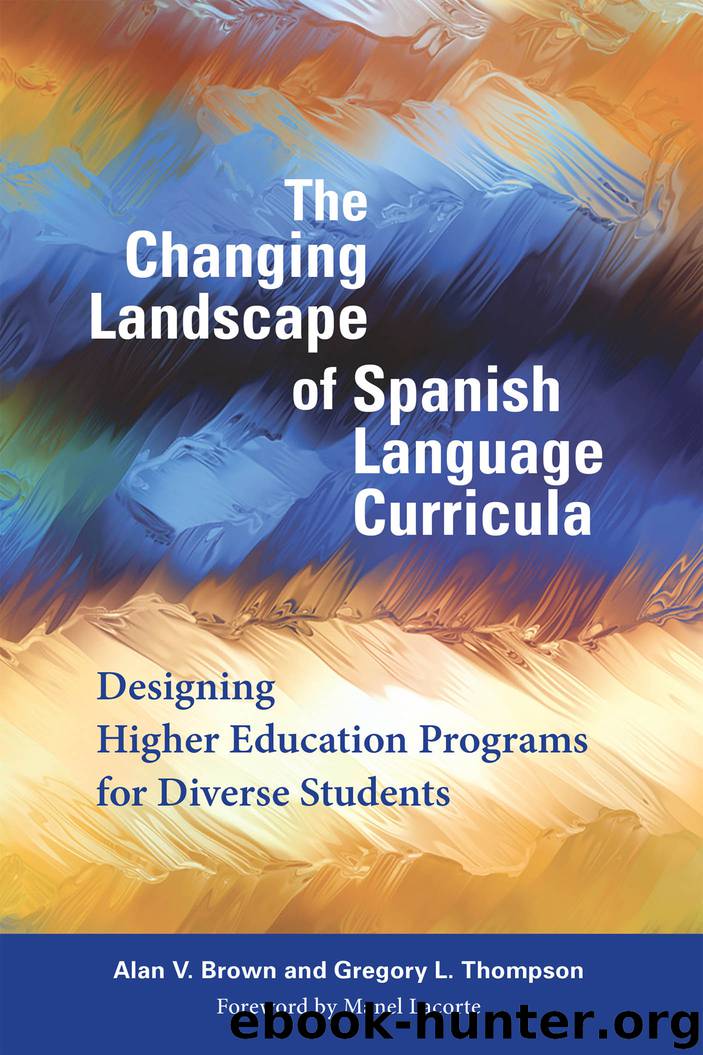The Changing Landscape of Spanish Language Curricula by Brown Alan V.; Thompson Gregory L.; Lacorte Manel & Gregory L. Thompson

Author:Brown, Alan V.; Thompson, Gregory L.; Lacorte, Manel & Gregory L. Thompson
Language: eng
Format: epub
ISBN: 9781626165755
Publisher: Georgetown University Press
program evaluation
Our token Spanish student from earlier in the chapter who began with the placement exam before entering a well-conceived and articulated program grounded in a defensible curricular framework and an achievable set of SLOs has now completed all the requirements and is ready to graduate. As she exits the program, she may ask herself “What did I gain from my experience in this Spanish program?” and “What can I now do that I couldn’t before?” Unfortunately, in many cases logistical constraints and limited resources preclude a longitudinal analysis of student growth and may lead program evaluators to only look at the achievement of learning outcomes in the aggregate from a cross section of students, essentially nullifying potentially large or small learning gains at the individual level. The heterogeneous nature of Spanish majors who exit a program could possibly mask unique and idiosyncratic growth, or a lack thereof, by individual students. The true beginner may grow tremendously from entrance to exit, but not reach the levels of classmates who entered with much more background, whereas the heritage speaker who entered with superb conversational ability may perform well in oral assessments but may have grown little in acquiring formal reading and writing skills. The diverse nature of incoming cohorts of Spanish students presents unique challenges when programmatic assessments are undertaken.
Spanish language programs at the collegiate level are complex and have many moving parts, such as the students and their backgrounds and goals, the instructional staff and their unique teaching and research proclivities, the integration of newly approved courses, and the shifting content of established courses. Additional complexity is introduced by pressures emanating from a range of sources—accrediting agencies, upper-level administrators, and legislatures, among others. As such, meaningful program evaluation can be an overwhelming task to undertake and one that requires not only faculty buy-in on an intellectual level but also significant contributions from faculty members on a practical level. In many cases, program evaluation has been done incrementally, befitting the needs of a program with only one component being targeted, or a limited number of components, to ensure that meaningful change results (Norris et al. 2009). Norris and Mills (2014) point out that effective, useful program evaluation can (1) shed light on the achievement of goals and on strengths and weaknesses, (2) demonstrate effectiveness to stakeholders, and (3) facilitate the identification of actions plans for improvement.
The realization of these benefits, which have the potential to effect real and lasting change in Spanish tertiary programs, hinges primarily on willful participation by core stakeholders, who then develop a sense of ownership of the process, which increases the use and usefulness of the evaluation (Davis et al. 2016). Michael Patton’s (2008) utilization-focused framework argues that all attempts at program evaluation should begin by identifying the intended users of the results and by cautiously and honestly anticipating the specific uses. Until these preliminary steps are completed, the process of formulating evaluation questions, selecting methods for data collection, collecting and analyzing the data, and reporting the
Download
This site does not store any files on its server. We only index and link to content provided by other sites. Please contact the content providers to delete copyright contents if any and email us, we'll remove relevant links or contents immediately.
| Anthropology | Archaeology |
| Philosophy | Politics & Government |
| Social Sciences | Sociology |
| Women's Studies |
Cecilia; Or, Memoirs of an Heiress — Volume 1 by Fanny Burney(32435)
Cecilia; Or, Memoirs of an Heiress — Volume 2 by Fanny Burney(31871)
Cecilia; Or, Memoirs of an Heiress — Volume 3 by Fanny Burney(31856)
The Great Music City by Andrea Baker(31359)
We're Going to Need More Wine by Gabrielle Union(18969)
All the Missing Girls by Megan Miranda(15579)
Pimp by Iceberg Slim(14395)
Bombshells: Glamour Girls of a Lifetime by Sullivan Steve(13976)
Talking to Strangers by Malcolm Gladwell(13222)
Norse Mythology by Gaiman Neil(13208)
Fifty Shades Freed by E L James(13157)
For the Love of Europe by Rick Steves(13032)
Mindhunter: Inside the FBI's Elite Serial Crime Unit by John E. Douglas & Mark Olshaker(9203)
Crazy Rich Asians by Kevin Kwan(9168)
The Lost Art of Listening by Michael P. Nichols(7408)
Enlightenment Now: The Case for Reason, Science, Humanism, and Progress by Steven Pinker(7237)
The Four Agreements by Don Miguel Ruiz(6634)
Bad Blood by John Carreyrou(6552)
Weapons of Math Destruction by Cathy O'Neil(6146)
